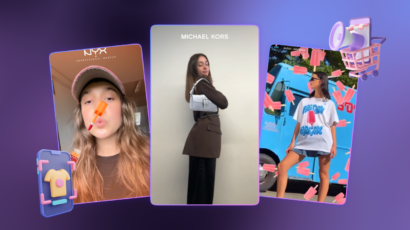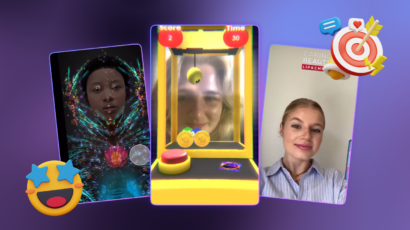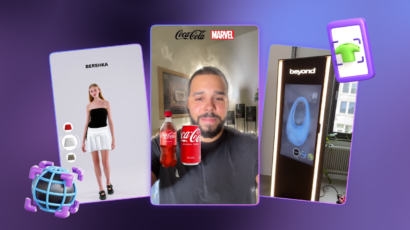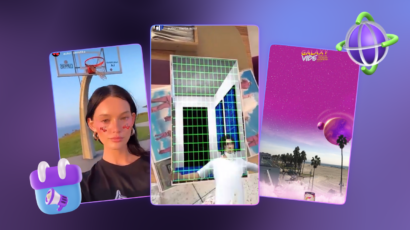The use of Augmented Reality (AR) in museums and galleries to interact with visitors and improve their experiences is taking these areas to the next level and transforming them already.
This ground-breaking technology is changing how we perceive art, history, and culture. AR offers a world where the present is just a touch away and the past comes to life.

Unleashing Unforgettable AR Experiences To Generate Interest And Engagement
The famous artist Jeff Koons and Snapchat collaborated on international virtual art installations. Inspired by some of his most well-known sculptures, Koons created Snapchat Lenses. The magic of AR allowed these art installations to appear in famous parks and sites all over the world, including the US, Canada, the UK, Paris, Australia, and Brazil. At the right spot, users may hold up their phones and see Koon’s glittering sculptures as if they were right in front of them.
This experience is an excellent illustration of how to create immersive and interactive experiences that compel visitors to spend more time looking at the artwork and engage them in profoundly unforgettable experiences with no effort on their part. It is more brilliant than the artist, and it is also quite effective at generating interest in and zeal for the arts.
This approach might also be a great way for reducing costs. Producing pricey printed materials for marketing initiatives, such as banners or flyers, maybe time- and money-consuming. By developing compelling and interactive campaigns without the requirement for tangible assets, AR marketing can provide a cost-effective alternative.
Reaching a Wider Audience with Dynamic AR World Effects

The Perot Museum of Nature and Science created a Snapchat AR filter to celebrate dinosaurs. Using Snapchat, with the aid of AR – visitors to the museum could engage with “Pachy,” the northernmost horned dinosaur.
AR technology can be utilised to create historical reenactments that bring historical events to life. Visitors may then have a greater understanding of the exhibit’s historical setting.
Snapcodes of the dinosaurs found at the museum can be scanned to activate the lens in one of the simplest methods possible. The user gets 24 hours to interact with the app after it identifies the Snapcode. They also can have fun taking selfies with “Pachy ” or they can just tap and create a route on their screen, and the dinosaur will come to life and follow it. As a reward, “Pachy” will pause and consume some flora at the end of the line. What’s more, they can save or share the image or video they just took via social media after taking it. Sharing this kind of content on social media is an effective way for any brand to build their identity and drive more traffic, in this case to the exhibition. Moreover, it may be challenging to draw in new customers due to the limited reach of traditional marketing techniques. By utilising social media and other digital platforms to promote exhibits and engage potential visitors, AR marketing may engage a wider audience.
The museum utilized numerous applications of augmented reality and found a fantastic approach to engage visitors. Almost 50K people had viewed the filter after 6 weeks. This expansion was entirely organic.
AR technology may make static exhibits into interactive ones, bringing them to life by superimposing digital content like 3D models, films, and audio over the actual display. This may encourage people to stay longer and offer a more immersive experience.
Expanding Limited Space with Image Tracking AR
Visitors’ levels of engagement might be low when exhibits are either overpowering or unimpressive. Through a more immersive and engaging experience, AR technology can entice visitors to explore a museum or gallery more thoroughly and for longer periods of time.
As for the AR exhibition – with pieces from London’s top institutions and the Sky Arts Portrait Artist of the Year, London’s Art Gallery offers viewers a fresh perspective on art and a novel method to engage with an exhibition.
Image tracking AR, which is used for this experience, gives visitors more background and information about the displays so they can understand and enjoy them more.
With a user-friendly AR app, the Augmented Gallery presents a cutting-edge public art experience that is free and features artworks from some of London’s top institutions.
This case also shows a great use of AR to solve objective of the limited space. As museums and galleries frequently have little amount of space, it may be challenging to show all of the exhibits and artefacts. By extending the physical space virtually, AR technology enables visitors to experience more exhibitions and artefacts without needing more physical space.
How AR Technology Can Help Redefine Physical Fashion and Reach a Global Audience
@crosscreators Come to a Vogue AR exhibition with us in London ✨ #ar #augmentedreality #crosscreators #vogue #snapchat #fyp #foryou
Redefining the Body is a ground-breaking partnership between Vogue and Snapchat that shows how AR can advance the field of physical fashion by enhancing and changing clothing designs through cutting-edge digital experiences that are accessible to a diverse global audience on Snapchat.
The exhibition had its debut at the Centre d’art La Malmaison in Cannes in June 2022.
Six of the most prestigious fashion houses and designers in the world are represented in this inventing exhibition: Dior, Kenneth Ize, Richard Quinn, Stella McCartney, Thebe Magugu, and Versace. Each is a pioneer in the contemporary reconfiguration of ideas about the body, investigating race, gender, age, sexuality, and size. With the use of Snapchat’s interactive AR Lenses, which have the ability to animate, reflect, refract, and evolve the person or image in view, the traveling display Vogue x Snapchat: Rethinking the Body demonstrates how these various interpretations of the physical form can be improved.
AR Technology As The Game-Changing Marketing Tool For Museums and Galleries

AR marketing for museums and galleries offers several key benefits, including increased engagement, extended reach, and improved accessibility. AR enables visitors to engage with the artwork and the exhibition space in a more interactive and dynamic way. AR technology can extend the reach of museums and galleries by offering virtual tours that can be accessed from anywhere in the world, making art and culture more accessible to people who might not otherwise be able to visit in person.
This type of engagement not only provides a more enjoyable experience for visitors but also increases the likelihood of them sharing their experience with others, thus extending the reach of the museum or gallery. Additionally, AR technology can help museums and galleries target specific audiences, such as younger generations who may be more technologically savvy. AR marketing allows you to showcase your exhibits and collections in a way that traditional marketing methods cannot.
If you want to stay ahead of the curve and provide a memorable experience for your visitors, implementing AR marketing in your strategy is a necessity. By doing so, you can address pain points in your marketing strategy and offer unique and engaging experiences that will leave a lasting impression on your visitors. So don’t hesitate to schedule a consultation with us to tailor your personalized AR strategy.







